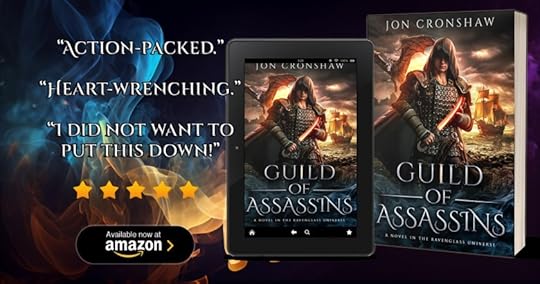Why Modern Fantasy Assassins Are More Complex Than Ever
Fantasy’s love affair with assassins has come a long way from silent killers lurking in shadows.
Modern fantasy has transformed the archetype from simple dealer of death into something far more complex.
It’s now a lens through which we examine mortality, morality, and the price of power.
Guild of Assassins: A Perfect Example of EvolutionMy novel Guild of Assassins represents this evolution perfectly.
When Soren enters the guild, he encounters not just killers, but professionals practising a dark craft.
Each master embodies different aspects of the trade.
Varus demonstrates martial prowess, Tamasin teaches the poisoner’s art, Quillon embodies clinical precision, and Elysia masters manipulation.
Like the best modern assassin fantasy, it presents killing as a multifaceted discipline requiring both physical and psychological transformation.
Shifting Away from Traditional Fantasy AssassinsThis marks a significant shift from traditional fantasy assassins, who often relied on almost supernatural stealth and combat abilities.
Think of Fritz Leiber’s Gray Mouser or early D&D representations – assassins as merely thieves with deadly skills.
Modern fantasy recognises that killing is as much about psychology as it is about physical capability.
The Lineage of the Assassin ArchetypeThe evolution becomes clear when we trace the lineage of assassin characters.
Early works like Raymond E. Feist’s Assassin’s Apprentice began exploring the psychological toll of killing.
Brent Weeks’ Night Angel trilogy expanded this by examining how institutions shape killers.
Jay Kristoff’s Nevernight delved deep into the culture and philosophy of assassination.
Each iteration added layers of complexity to the archetype.
Assassins: Made, Not BornGuild of Assassins continues this trend by focusing on how killers are made rather than born.
Through Soren’s training, we see how ordinary people become extraordinary killers through systematic breaking and rebuilding.
Each lesson strips away another piece of humanity while adding another lethal capability.
It’s a transformation that feels horrifyingly plausible.
Killing as a Transformation of PerceptionModern assassin fantasy also recognises that killing isn’t just about the act itself.
When Soren learns from Tamasin about poisons or studies manipulation with Elysia, he’s not just gaining skills.
He’s entering a different way of seeing the world.
Like the best contemporary takes on assassins, the story shows how the craft reshapes perception itself.
Complex Assassin InstitutionsThis complexity extends to institutions.
Gone are the days of lone killers operating in shadows.
Modern fantasy presents assassins’ guilds as complex organisations with their own cultures, traditions, and moral codes.
The guild in Guild of Assassins feels real precisely because it has bureaucracy, politics, and internal conflicts alongside its deadly arts.
Training Beyond Physical SkillsThe training sequences particularly highlight this evolution.
Earlier fantasy might have focused purely on physical skills – weapon mastery, stealth, poison craft.
Modern takes recognise that creating killers requires psychological conditioning.
The guild doesn’t just teach Soren how to kill; it teaches him to see killing as natural.
Evolving Relationships Among AssassinsRelationships between assassins have evolved too.
Where once they might have been depicted as lone wolves, modern fantasy explores how killers form bonds.
Soren and Alaric’s friendship, the complex dynamics between recruits, and the master-apprentice relationships all show how human connections persist even in inhuman professions.
Exploring Deeper Themes Beyond TechniquePerhaps most significantly, modern assassin fantasy has moved beyond simple questions of technique to explore deeper themes.
Through Soren’s journey, we examine how violence transforms its practitioners.
We see how institutions normalise atrocity and how survival demands moral compromise.
The assassination becomes a metaphor rather than a mere plot device.
The Threshing: A Crucible for TransformationThe Threshing sequence demonstrates this perfectly.
It’s not just a test of killing skill but a crucible that forces characters to confront what they’ve become.
Like the best modern assassin fantasy, it uses violence to illuminate character rather than simply advance plot.
Broader Changes in Fantasy LiteratureThis evolution reflects broader changes in fantasy literature.
As the genre has matured, it’s moved from simple adventure stories to complex examinations of human nature.
Assassins have evolved from plot devices into vehicles for exploring fundamental questions about mortality, morality, and the human capacity for transformation.
The Primal Appeal of Assassin StoriesYet something primal still draws us to assassin stories.
Perhaps because they embody both power and price – the ability to reshape reality through death, but only at the cost of one’s humanity.
Modern fantasy simply makes this exchange more explicit, more psychological, more real.
Guild of Assassins and the Future of Assassin TropesGuild of Assassins shows where the trope might go next.
Deeper into institutions, deeper into psychology, deeper into the fundamental questions of what it means to kill professionally.
It suggests that assassin fantasy’s evolution isn’t complete but is continuing into ever more complex territory.
Your ThoughtsHow do you think assassin tropes in fantasy have changed over time?
What’s your favourite take on fantasy assassins?
Share your thoughts below.

The post Why Modern Fantasy Assassins Are More Complex Than Ever first appeared on Jon Cronshaw.



